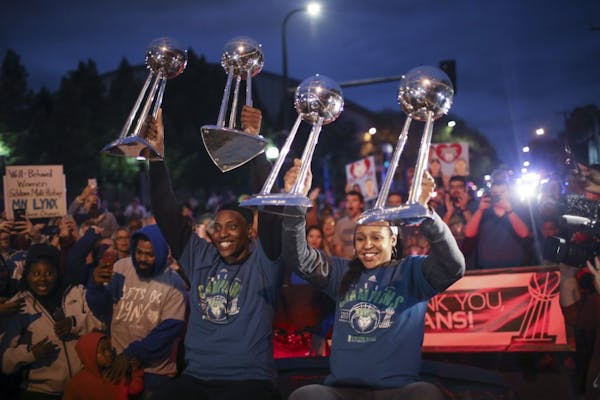The WNBA, which will bring its All-Star Game to Target Center on Saturday, is in the midst of its 22nd season. Some teams are still trying to make a profit and some franchises are moving; the San Antonio Silver Stars just moved to Las Vegas and the New York Liberty, on the sales block, moved this year from Madison Square Garden to a smaller arena in Westchester County.
So, you might think, is there trouble in this 12-team league?
Not really, no.
Indeed, WNBA President Lisa Borders, though loath to provide financial specifics, will tell you the league is healthier than it has ever been — both on the court, where talent is flourishing, and off, with increased viewership, a leaguewide sponsorship by Verizon, individual team sponsors and a long-term TV deal with ESPN, among other revenue streams.
"Look at points, shooting, steals, blocks," she said. "By any traditional basketball metric, you will see the quality of the game continues to improve. I can tell you, we're really pleased."
The talent level continues to rise, with the influx of college players. With 144 roster spots, most teams have multiple star-quality players. Additionally, the playoff race is as tight as ever.
That's not to say there aren't issues. At least some players have begun to talk about upping their share of the league's revenue pie. There are still teams searching for their way out of the red into profitability. Fans are still waiting to see where the Liberty will end up.
But the league feels good as it makes its way to the Twin Cities for this weekend's events.
"I think we are reaching a point, societally, that women playing sports, we're feeling a little more of a wave of positive direction," said Lynx General Manager and coach Cheryl Reeve, who has been in the WNBA since 2001.
Trending in right direction
To David Berri, the best comparison for the WNBA's overall health and stability is the NBA at the same stage. Berri is a professor of economics at Southern Utah University and a frequent contributor to Forbes who has spent two decades researching the economics and gender issues that surround sports.
For the 1967-68 season the NBA, 22 years old, had just added two teams for a total of 12. Teams still flew commercial, salaries were far lower and the league averaged 6,749 fans per game. Of the 12 teams, three would move — St. Louis Hawks to Atlanta the next season, the San Diego Rockets to Houston in 1971, and the Cincinnati Royals to Kansas City in '72 before becoming the Sacramento Kings in 1985.
So, you had a 12-team league, with many teams still searching for profitability and franchises moving all over the map.
Sound familiar?
"Look at the NBA's first 20, 30 years, it's exactly the same story," Berri said. "It's also the same story of the early NFL, or Major League Baseball, or the NHL. All these stories are very similar. The reason I think this happens is that, professionally, when they start, you are inventing an organization that didn't exist before and doesn't have any fans. Fans identify with players to some extent, but also to organizations. When you invent a league, initially nobody knows what they're looking for. There is no history."
That is changing for the WNBA. Viewership is ticking up. Viewership on ESPN2 through its nine televised games is up 53 percent at this same point last year. Viewership on NBA-TV through 25 games has shot up 48 percent, the network reports. Attendance, which rose in 2016 and 2017, might drop a bit overall because of the Liberty's move but remains strong. The Lynx are averaging about 10,000 fans this year.
"People look and they say, 'The WNBA doesn't draw; that proves men's sports are more popular,' " Berri said. "It proves nothing. Women's sports has been around a few decades, men's for hundreds of years. You have to put it in perspective."
But there has been an evolution in the way the league is run. Reeve entered the league in 2001 as an assistant with the now-defunct Charlotte Sting.
Back then the WNBA, with all teams owned by NBA teams, was filled with franchises that bled money. Expenditures were way out of line; Reeve remembers bringing in players for the preseason, spending the money to house and feed them, while waiting for the regulars to come back from overseas. Teams lost millions of dollars.
Still, attendance was very high at the start. But when the novelty wore off and revenue dropped, the league was forced to change. It got smaller — the original eight-team WNBA expanded to twice that size in the early 2000s and is now composed of 12 teams. Teams learned to operate more leanly and today, five of the teams are owned by NBA franchises.
"The league has gotten a lot smarter, in terms of where expenditures should be," Reeve said. "It's more under control."
The league has also done a better job of marketing, according to UNLV professor Nancy Lough, whose expertise includes gender equity in sports. She sees a league selling itself to families as well as to segments of the population not usually marketed to, such as the LGBT community.
"They have realized who their fans are, and that they need to differentiate their brand in a way that honors who their fans are," she said.
Meanwhile, the athletic level of players has gotten to a point where many feel there is talent enough to consider expansion.
"We're cutting great players all the time," Las Vegas coach Bill Laimbeer said.
Seattle Storm coach Dan Hughes has been coaching in the WNBA since 1999. He started with the Charlotte Sting, one of the original franchises that folded in 2007. Then he coached in Cleveland, where the Rockers met the same fate. For 11 years he coached the San Antonio Stars, who just moved to Las Vegas.
"The biggest change, without question, is the athletic nature of this league," Hughes said. "The ability of players to get their own shots. With the talent coming into this league, with what we already have, there is room for more players having a role."
But don't look for expansion to happen right away. When it comes to the WNBA, patience is the key.
"Economically we're not at a place where we're willing to expand," Borders said. "We want to make sure each of our teams is on stable operational financial footing before we reach for more."
Players want bigger salaries
Some players are already asking for more.
WNBA revenue is a small fraction of what the NBA pulls in. We're talking billions compared to millions. This season, the top salary in the WNBA is $115,500, and some think it should be more.
Exact revenue data is hard to come by, but some, including Berri, have tried.
Berri started with the league's ESPN contract, worth $25 million per season. Then, trying to estimate a gate, he took total league attendance from last season, averaged the minimum ticket prices for eight of the league's teams and came up with another $26-plus-million. Not counting league and team sponsorships, he puts league revenue from last year at least at $51.5 million.
Bottom line: According to Berri — though there are those in the league who say he has overestimated — players are getting north of 22 percent of league revenue, compared to 50 percent in the NBA.
"We're not asking for millions and millions of dollars," Las Vegas guard Kelsey Plum said. "We're asking to have the same percentage of revenue on our [collective bargaining agreement] that the NBA has. I don't think that's too much to ask for."
She's not alone. Plum's teammate, rookie A'ja Wilson, went viral on Twitter talking about LeBron James' contract with the Los Angeles Lakers in contrast to WNBA players' salaries. Longtime star Diana Taurasi recently told reporters players have to be "willing to lose everything" in any future negotiations with the league. The WNBA Players Association can opt out of the current CBA next year.
Taurasi said being willing to strike is the only way to get a better deal.
Seimone Augustus is the Lynx's player rep.
"We need to address the wage gap in total revenue," she said. "And we will get there. But the ladies, they have to step up. They have to step up next year. They have to want to do this. We've talked about this before, and when it came down to it, people kind of backed down. We hear the same stuff. The league isn't ready for a strike or can't handle a strike. We might lose what we have. Hopefully, in a year, the ladies will want to put their foot down."
Without speaking to specifics, Borders said the two sides will talk when it's time.
"What we're not going to do is litigate this in the public domain," she said.
This much is certain: The fans will see a talented, athletic, fast-paced All-Star Game this weekend, on national TV. And Berri, for one, thinks this is only the start.
"The WNBA is doing perfectly well," he said, adding, "I'd say 20, 30 years from now we'll look back and say, 'Of course it was going to grow,' " Berri said.

Lacrosse 2024: Boys or girls, discussion begins in the same place

Penn State's starting goalie transfers to Gophers men's hockey

Will 'shotgun only' zone for deer in southern Minnesota be abolished?
NFL draft has potential to set a record for most players on offense selected in the first round


